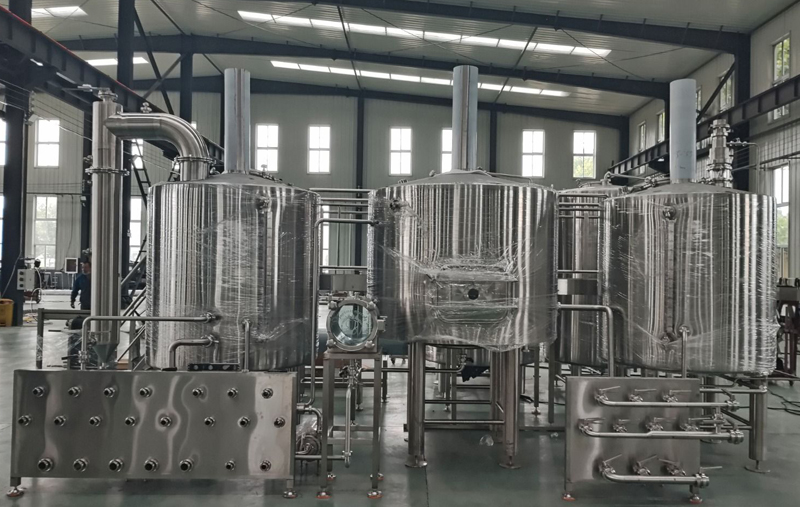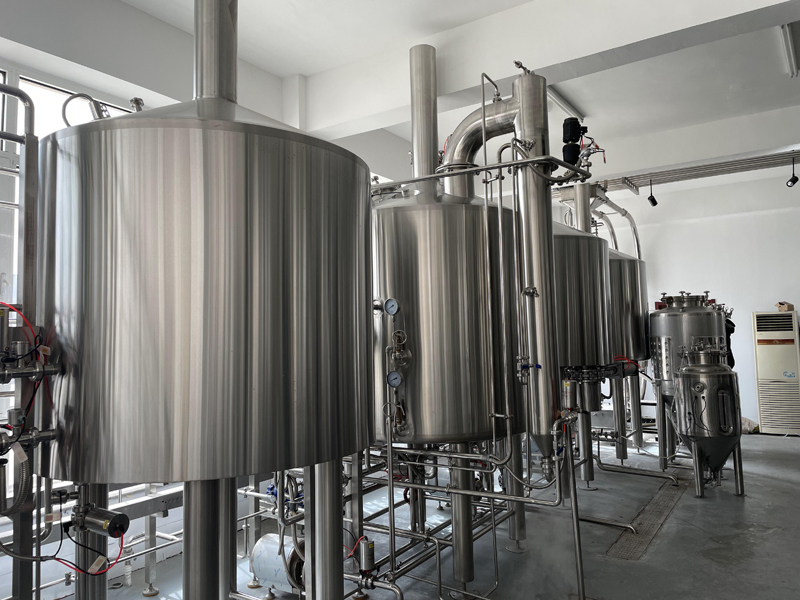The role of brewhouse system in entire brewery

1.Brief Introduction To The Brewhouse Equipment
The brewhouse equipment is the core of any brewery, where the foundational processes of brewing take place. It consists of a series of specialized equipment designed to convert raw ingredients into wort, which is the precursor to beer. Key components include the mash tun, where malted grains are mixed with hot water to extract fermentable sugars; the lauter tun, which separates the liquid wort from the spent grains; and the brew kettle, where the wort is boiled and hops are added for bitterness, flavor, and aroma. Additional essential equipment includes the whirlpool for clarifying the wort and the heat exchanger for rapid cooling. Each piece of equipment plays a vital role in ensuring the precision and efficiency of the brewing process, contributing to the quality and consistency of the final product. Understanding these components can help us understand the complexity and craft of brewing.
Key Components Of The Brewhouse Equipment
The brewhouse equipment is a complex and well-orchestrated system where raw ingredients undergo critical transformations to become wort, the liquid that will eventually ferment into beer. The efficiency and quality of the brewing process hinge on the optimal performance of several key components: the mash tun, lauter tun, boil kettle, whirlpool, and heat exchanger. Each piece of equipment has a distinct role, contributing to the precision and consistency necessary for producing high-quality beer.
Mash Tun
The mash tun is the starting point of the brewing process. Here, milled malted barley (and sometimes other grains) is combined with hot water in a process called mashing. This step activates enzymes within the malt, particularly alpha-amylase and beta-amylase, which break down complex starches into simpler fermentable sugars. The mash tun is equipped with temperature control systems to maintain the optimal range for enzymatic activity, typically between 148°F to 158°F (64°C to 70°C). The efficiency of starch conversion in the mash tun directly influences the beer’s potential alcohol content and overall flavor profile.
Lauter Tun
After mashing, the mash is transferred to the lauter tun, where the liquid wort is separated from the spent grains. The lauter tun features a false bottom or a series of slotted plates that allow the liquid to pass through while retaining the solid grain particles. This process, known as lautering, includes sparging—rinsing the grain bed with hot water to extract as much fermentable sugar as possible. Effective filtration ensures maximum yield of wort and thus the desired beer volume and quality. The design of the lauter tun, including its internal geometry and rinse water distribution method, can have a significant impact on the efficiency and clarity of the wort.
Boil Kettle
The wort is then transferred to the boil kettle, where it is boiled typically for 60 to 90 minutes. Boiling serves multiple purposes: it sterilizes the wort, ensuring that any unwanted microorganisms are destroyed; it facilitates the isomerization of alpha acids from hops, imparting bitterness to balance the sweetness of the malt; and it evaporates volatile compounds that could cause off-flavors. The boil kettle is also where brewers add hops at various stages to contribute bitterness, flavor, and aroma. The design of the boil kettle, including its heating elements and boil dynamics, is critical for maintaining a vigorous boil and achieving the desired hop utilization and wort clarity.
Whirlpool
Following the boil, the wort is transferred to the whirlpool. This vessel uses centrifugal force to separate solid particles, known as trub, from the liquid wort. As the wort is pumped into the whirlpool at high velocity, it creates a vortex that collects the trub in the center of the vessel, allowing the clear wort to be drawn off from the perimeter. This step is essential for removing hop particles and coagulated proteins, resulting in a clearer wort that will ferment more cleanly. The whirlpool design, including its inlet and outlet positioning, significantly affects the efficiency of trub separation.
Heat Exchanger
The heat exchanger rapidly cools the hot wort to a temperature suitable for fermentation, typically between 65°F to 75°F (18°C to 24°C) for ales, and even lower for lagers. This rapid cooling is crucial to prevent the growth of unwanted microorganisms and to quickly bring the wort to the optimal temperature for yeast activity. The heat exchanger typically consists of a series of plates or tubes where hot wort flows on one side and cold water or glycol on the other, facilitating efficient heat transfer. Heat exchanger design and operation can help maintain wort integrity and ensure consistent fermentation performance.
Each component of the brewhouse equipment plays a critical role in the brewing process, working in harmony to convert raw ingredients into high-quality wort. Understanding the functions and interactions of wort tubs, lauter tuns, boil kettles, vortexer, and heat exchangers can help understand the complexity and craft of beer brewing.

The brewhouse equipment is a center of scientific processes where various biochemical and physical reactions transform raw ingredients into wort, the precursor to beer. Understanding these scientific principles provides insight into the meticulous craftsmanship and precision required in brewing. Key scientific processes in the brewhouse equipment include enzymatic reactions, Maillard reactions, hop utilization, cooling, and oxygenation.
Enzymatic Reactions
The brewing process begins in the mash tun, where enzymatic reactions are critical. When malted barley is mixed with hot water, enzymes such as alpha-amylase and beta-amylase are activated. These enzymes catalyze the breakdown of complex starches into simpler fermentable sugars like maltose and glucose. The optimal temperature range for these reactions is typically between 148°F and 158°F (64°C to 70°C). Enzyme activity is also influenced by the pH level, which should ideally be between 5.2 and 5.6. Proper control of these conditions ensures efficient starch conversion, influencing the beer’s potential alcohol content and sweetness.
Maillard Reactions
During the boiling process in the brew kettle, Maillard reactions occur. These non-enzymatic browning reactions involve amino acids and reducing sugars, producing a range of flavor compounds and contributing to the color of the wort. The Maillard reaction is enhanced by high temperatures and extended boiling times. These reactions add complexity and depth to the beer’s flavor profile, creating notes of caramel, toffee, and roasted flavors depending on the ingredients and conditions used. Controlling the Maillard reaction helps create the desired taste and appearance of beer.
Hop Utilization
Hops are added to the wort during the boil in the brew kettle, contributing bitterness, flavor, and aroma to the beer.
The key chemical process here is the isomerization of alpha acids in hops into iso-alpha acids, which provide bitterness.
The efficiency of hop utilization is influenced by the boiling time, temperature, and wort pH.
Typically, hops added early in the boil contribute more bitterness, while hops added later contribute more flavor and aroma due to the preservation of volatile compounds.
Managing hop additions precisely allows brewers to balance the bitterness and aromatic qualities of the beer.
Cooling
After boiling, the wort must be rapidly cooled to fermentation temperature using a heat exchanger.
This process involves transferring heat from the hot wort to a cooling medium, usually cold water or glycol, through a series of plates or tubes.
Rapid cooling prevents the growth of harmful microorganisms and ensures that the wort reaches the optimal temperature for yeast fermentation.
The efficiency of the heat exchanger depends on the surface area, flow rates, and temperature differentials. Effective cooling preserves the integrity of the wort and sets the stage for a clean fermentation process.
Oxygenation
Once the wort is cooled, it must be oxygenated before yeast is added for fermentation. Oxygenation is critical because yeast requires oxygen for the synthesis of sterols and unsaturated fatty acids, which are essential for cell membrane development and yeast health.
Oxygen is typically introduced into the wort by aeration or oxygen injection. The amount of oxygen dissolved in the wort must be carefully controlled, too little oxygen can lead to sluggish fermentation and off-flavors, while too much can lead to oxidative damage.
Proper oxygenation ensures robust yeast activity and healthy fermentation, resulting in a clean and well-attenuated beer.
Other Critical Processes
&Clarification and Trub Separation: After the boil, the wort is transferred to the whirlpool, where centrifugal forces help separate solid particles, known as trub, from the liquid wort.
Effective trub separation is crucial for producing a clear wort, which in turn leads to cleaner fermentation and a higher-quality final product. The design of the whirlpool, including the inlet and outlet positioning, is optimized to maximize trub separation and minimize wort losses.
&Yeast Fermentation: Though not strictly part of the brewhouse equipment, yeast fermentation is a crucial subsequent step where the science of brewing continues.
Yeast metabolizes the fermentable sugars in the wort, producing alcohol, carbon dioxide, and various flavor compounds.
The specific yeast strain, fermentation temperature, and wort composition significantly influence the beer's final flavor profile. Understanding yeast metabolism and managing fermentation conditions can help produce consistent, high-quality beer.
The brewhouse equipment is a sophisticated environment where various scientific principles and reactions come into play to transform raw ingredients into wort.
Enzymatic reactions in the mash tun, Maillard reactions and hop utilization in the boil kettle, rapid cooling in the heat exchanger, and oxygenation before fermentation are all essential processes that require precise control and understanding.
Each of these processes contributes to the quality, flavor, and consistency of the beer. By mastering the science behind these reactions, brewers can craft a wide variety of beer styles, each with its unique characteristics and appeal.

3.Impact Of Brewhouse Equipment
Brewhouse equipment is pivotal to the brewing process, influencing every aspect from the initial conversion of raw materials to the final product.
Its impact spans quality control, sustainability and efficiency, and the ability to produce diverse beer styles. Each of these aspects is crucial for a brewery's success and reputation.
Impact On Quality Control
Quality control during the brewing process helps ensure that each batch of beer meets consistent standards for taste, aroma, appearance, and overall quality. Brewhouse equipment plays a central role in achieving this consistency.
Precision and Consistency: Advanced brewhouse equipment allows for precise control over critical brewing parameters such as temperature, pH, and timing. Automated systems and sensors help maintain these parameters within tight tolerances, reducing variability between batches and ensuring consistent product quality.
Monitoring and Data Collection: Modern brewhouse equipment is equipped with sophisticated monitoring systems that collect real-time data on the brewing process. This data can be analyzed to detect any deviations from the desired conditions, allowing brewers to make adjustments promptly. Continuous monitoring helps identify potential issues before they affect the final product.
Sanitation and Hygiene: High-quality brewhouse equipment is designed for easy cleaning and sanitation, reducing the risk of contamination. Clean-in-place (CIP) systems automate the cleaning process, ensuring that tanks, pipes, and other equipment are thoroughly sanitized. This minimizes the risk of microbial contamination, which can adversely affect beer quality.
Impact On Sustainability And Efficiency
Sustainability and efficiency are increasingly important in brewing, both for environmental reasons and economic viability. Brewhouse equipment significantly impacts these areas through resource conservation and operational efficiency.
Energy Efficiency: Modern brewhouse equipment is designed to minimize energy consumption. Heat recovery systems, efficient boilers, and well-insulated vessels help reduce the amount of energy required for processes such as mashing, boiling, and cooling. By optimizing energy use, breweries can lower their carbon footprint and reduce operational costs.
Water Conservation: Water is a critical resource in brewing, used in various stages including mashing, cooling, and cleaning. Advanced brewhouse equipment incorporates water-saving technologies such as recirculation systems and efficient CIP processes. These systems reduce water waste and allow for the reuse of water where possible, promoting sustainability.
Waste Management: Efficient brewhouse equipment also plays a role in managing waste. Systems designed for effective trub and spent grain separation ensure that these by-products can be repurposed, such as for animal feed or composting. Wastewater treatment systems help breweries treat and reuse water, reducing the environmental impact.
Automation and Optimization: Automated brewhouse systems enhance efficiency by streamlining operations and reducing manual labor. These systems optimize the use of raw materials and energy, minimizing waste and maximizing yield. Automation also allows for more consistent production schedules, improving overall operational efficiency.
Impact On Beer Style
The design and functionality of brewhouse equipment significantly influence the range of beer styles a brewery can produce. Different beer styles require specific processes and conditions, which are facilitated by specialized equipment.
Versatility in Brewing Processes: High-quality brewhouse equipment provides the versatility needed to produce a wide variety of beer styles. For example, equipment that can precisely control temperature and stage mash can produce complex, malty, and rich beers like bocks and stouts. Likewise, equipment designed for efficient hop utilization and late hop additions can produce hop-heavy beer styles like IPAs and pale ales.
Flavor and Aroma Development: The ability to control boil intensity, hop additions, and fermentation conditions allows brewers to fine-tune the flavor and aroma profiles of their beers. For example, a well-designed whirlpool can enhance hop aroma by effectively separating trub while preserving volatile hop compounds. fermentation tanks with precise temperature control enable desired ester and phenol profiles to be achieved in ales and lagers.
Consistency and Reproducibility: Advanced brewhouse equipment ensures that specific beer styles can be reproduced consistently. This is important for maintaining brand identity and meeting consumer expectations. Automated recipe management systems allow brewers to replicate successful batches with high accuracy, ensuring that each beer style maintains its unique characteristics across different production runs.
Innovation and Experimentation: Modern brewhouse equipment also supports innovation and experimentation. Brewers can experiment with different ingredients, brewing techniques, and fermentation processes to create new and unique beer styles. This flexibility can help stay competitive in a dynamic market and meet changing consumer preferences.

Brewhouse equipment is fundamental to the brewing process, with a profound impact on quality control, sustainability and efficiency, and the ability to produce diverse beer styles. Advanced and well-designed equipment enables breweries to maintain high standards of quality, operate sustainably and efficiently, and offer a wide range of beer styles that meet consumer demands. By investing in state-of-the-art brewhouse equipment, breweries can enhance their operational capabilities and continue to innovate in the craft of brewing.
 Jinan Alston Equipment Co.,Ltd.
Jinan Alston Equipment Co.,Ltd.